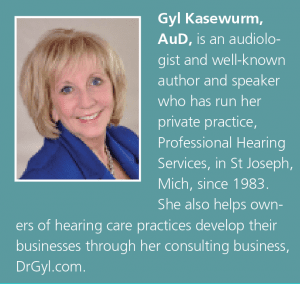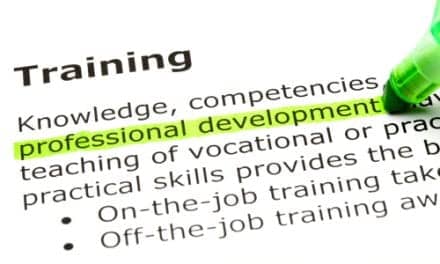Practice Management | December 2018 Hearing Review
How to thrive in today’s increasingly competitive hearing healthcare business
The hearing healthcare industry is changing. When I started my business, I was the only audiologist in a county of 150,000 people and now, 35 years later, I have 7 competitors within 7 miles. Competition seems to be coming from everywhere. A short list of “challenges” in our business includes:
- Big-box stores are killing us on price, and hearing aids are seemingly available everywhere;
- OTC hearing legislation has been approved and self-fitting devices are on the horizon;
- Insurance companies are turning over their hearing benefits to Internet providers;
- The reimbursement that we do receive is declining, and
- Yet, the percentage of people with hearing loss that get hearing aids doesn’t appear to be increasing.
All of these factors can make it difficult to operate a profitable practice. For many years, hearing healthcare professionals have had the luxury of being in a high-margin, low-volume business, but the trends have changed and practice owners are being forced to do more for less. Consequently, every practice owner needs a strategy for maximizing profitability.
My degree in audiology did not teach or prepare me to operate a successful business. I have faced many challenges over the many years as a practice owner. When confronted with difficulties, I sought out advice from other experienced professionals to help me create and sustain a profitable practice.
What I have learned is that business is business, no matter what type of business a person is in, and a business will not manage itself. It’s critical to have a strategy for success. I remember the turning point in my life as a practice owner when I said, “What the heck? I worked my butt off and I made less than my receptionist!” That’s when I became laser focused and devised a strategy for maximizing profitability. I call it the PMP Strategy: Plan It, Monitor It, and Push It.
Plan It!
Success doesn’t just happen. You have to make it happen. That takes a plan. As the saying goes: “Fail to plan and plan to fail.” If you want the business to grow, the plan has to be well thought out and very intentional.
It doesn’t matter how much gross revenue is generated if there is nothing left at the end of the month. Despite having a marketing plan to drive patients through our door, business started out extremely slow in February this year. It was easy to attribute the slowdown to the cold, snowy weather, but we didn’t let the blowing snow and below zero temperatures dampen our spirits. It was a perfect time to call patients that we had lost touch with. So, we printed a list of patients who hadn’t been in our office during the past year and got busy calling. It was amazing how fast our schedules filled up. While every appointment wasn’t an opportunity for a sale, it was a chance to reconnect with patients.
We put the plan in place so that our time was well spent, and every employee knew exactly what they needed to contribute to make the plan successful. As a result of being proactive and working the plan, we were able to experience a substantial increase in revenue in what typically had been one of our slowest months.
Monitor It!
Every practice owner has a multitude of duties to fit into their already busy schedules, but monitoring certain key aspects of the business is absolutely essential if you want to maintain a profitable business. Most owners think they are doing better than they actually are and that’s why it’s not a good idea to depend on instinct to determine how well a business is actually performing.
Most hearing care professionals spend 99% of their time working in their businesses and little time working on their businesses. I can imagine that some of you are wondering how you are going to have time to spend investigating numbers when you are already overworked seeing patients and handling all the other details necessary to run a business. The truth is, if you don’t spend time running your business, it will run you! The time you spend monitoring and managing your numbers will pay off. The business may survive (and even thrive) in spite of the lack of attention to business metrics, but the business is unlikely to reach its potential if you don’t use the data to drive more revenue into the practice.
As business owner, I have become a numbers fanatic because I have found that analyzing data is critical for making quick and important decisions that can affect the health of the business. Numbers tell a story, and at any given time, I can review the numbers and get a feel for how well the business is doing as compared to last year or last month, etc. When I keep an eye on the numbers, I don’t have to wonder how the business is doing. I know exactly how the business is doing.
In case you do not have any monitoring plans in place—and by the way, every electronic office management software (OMS) system collects data—begin by looking at the following numbers:
Help Rate. It has been estimated that the average practitioner convinces less than half of the people who need hearing aids to purchase them. I call this a Help Rate which can be defined as the percentage of patients who need hearing aids compared to the percentage who actually purchase them.
When determining Help Rate, it’s essential to have a concrete definition of who’s a candidate. At my practice, we consider anyone with thresholds greater than 25 dB at three frequencies or more and patients who have aids over 4 years old to be candidates. While there may be other patients with special circumstances outside of this criteria who need hearing aids, it’s critical to have a concrete definition so that everyone is using the same metric to determine their Help Rate.
Focusing on improving Help Rate can be the number one way to improve profitability. All hearing healthcare professionals hear the same objections from patients every day: “I don’t think my hearing is bad enough;” “Hearing aids cost a lot of money;” “I want to think about it;” and “I need to talk with my spouse or my children,” so we should be prepared and not surprised by the opposition. Learn how to handle these objections and your Help Rate will certainly improve and profitability is sure to increase.
If you only want to do one thing to grow your business and to benefit your patients, focus on your Help Rate!
Know your Break-even Point. The break-even point occurs when a business is neither making nor losing money. In other words:
Revenue = Total expenses
Of course, the goal of any business is to generate a profit over and above the break-even point. Fixed costs exist regardless of how much revenue is generated. They include expenses like rent, loan payments, employee wages, utilities, insurance, telephone, and Internet. Fixed expenses are bills that have to be paid every month. If you sell a product, the gross profit margin is the percentage of sales left after subtracting the cost of goods sold. There are many great resources and sample worksheets on the Internet to help determine the break-even point.
I was talking with a new business owner recently who had fulfilled her dream and opened a restaurant. The business had grown faster than expected and she was struggling to sustain a positive cash flow. She had hired several new employees to maintain a good service culture, and the increased expenses had forced her to take out a loan to cover her overhead. She wasn’t able to pay herself, but she was quite certain that when business increased, she would be able to pay back the loan and start taking a nice salary. However, she really had no idea how much revenue she needed to generate to operate the business or how much was necessary to produce enough excess cash to pay back her debts and to be able to pay herself a salary. She didn’t know her break-even point.
Similar situations can occur in every business. Many practice owners get so busy seeing patients that they hire more and more employees, only to find they don’t have enough money at the end of the month to pay themselves. If you want to have a profitable practice, every professional must be generating more than enough revenue to pay for themselves and their benefits. While a support person does not directly generate revenue, their activities must be contributing to the profitability of the practice by making appointments, contacting patients who haven’t been in, sending out notices about new technology, ordering supplies, etc. Know where your break-even point is!
COGS. Cost of goods sold (COGS) is the cost of acquiring or manufacturing the products that a company sells during a given period of time. The industry average for hearing aid COGS is less than 35%, and the lower the COGS the more profit for the business. It goes without saying that, as a business owner, you need to negotiate with vendors to ensure you’re getting a fair price and competitive COGS. Many people dread this job. But you need to put on your tough professional face and do it.
RFC rate. This statistic represents the number of hearing aids that were purchased and returned for a refund, or your return-for-credit (RFC) rate. However, this number may represent much more to the business as it indicates the number of patients who were dissatisfied with the result provided to them or with the way they were treated by personnel in the practice. A high RFC rate is something that should be investigated immediately.
Calls converted into appointments. It costs money and takes time to get the phone to ring. Every prospect who calls and does not make an appointment represents potential lost revenue. When a prospective patient calls your practice, the objective of the person who handles the call is to schedule an appointment. Consider hiring a call tracking service. CallSource (www.callsource.com) is an example of an excellent resource that will actually record phone calls coming into your practice so you can listen to them.
Accounts receivable. It is critical to keep a close eye on accounts receivable. One of the fastest ways to get into a cash-flow crisis is to provide goods and services to slow-paying customers—and that includes insurance companies. If payment gets too slow, it may be necessary to discontinue participation with certain third-party payers. While this may seem like a drastic move, if you aren’t getting paid or if you are providing services at dramatically reduced rates, it may be costing the business more than is beneficial. Another strategy to improve cash flow is to offer financing options to patients.
Push it!
As mentioned earlier, success doesn’t just happen, you have to make it happen, and you have to go over what you want. My favorite part of being self-employed and running an independent practice is that, if the business isn’t working well or generating the revenue expected, then I have the power to change things—quickly.
Most practices can and will survive; however, if you want to thrive, you have to push it! If you want to take your business to a greater level of profitability, I suggest developing a goal of where you would like the business to be at the end of a specific period of time.
Goals drive success. Goals without a formal action plan are merely dreams that probably will never happen. If you shoot for nothing, you will hit it every time! Once goals have been established, it’s a good idea to review them every month to see what worked and what needs changing. The business may be doing so well that it’s necessary to accelerate the goals to more closely align with what is actually happening. Creating and maintaining a profitable practice is about consistency and momentum, and about making changes when revisions are necessary.
It’s a big job running a practice but it’s certainly more rewarding when the business is a profitable one. If your practice isn’t as lucrative as you would like it to be, consider employing the PMP Strategy.
CORRESPONDENCE can be addressed to Dr Kasewurm at: [email protected]
DR Gyl instructs practice owners and managers about “Taking Your Practice from Fine to Fabulous.” Visit DrGyl.com to learn more.
Citation for this article: Kasewurm G. The PMP strategy for maximizing profit in your practice: plan, monitor, and push. Hearing Review. 2018;25(12)[Dec]:36-38.






